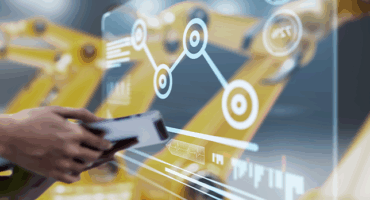Creative use of digital tools in gastronomy

Gastronomy is no longer just about food. In the era of automation, labor shortages and growing demands from clients, it is becoming more apparent that digital solutions can be a crucial element of success.
Even in corporate catering – from canteens, catering itself, to B2B services – technologies can be used in an effective and creative way.
Online orders and pre-orders
You choose a meal or menu and order it via the app or the website, for example a day in advance or for lunch in the morning hours. Such solutions are increasingly being used in company canteens, school canteens or company catering.
What are the benefits?
– a more precise overview of the required ingredients
– optimization of personnel capacities and less wasted ingredients
– better predictability of demand
How to improve this more: allow customers to set their “favorite selection” that will be displayed to them automatically in the app, or offer them recommendations based on their previous orders. Thus it will be easier for them to make a decision and at the same time you will increase the likelihood that they will order the meal again.
Digital menu and QR codes
In many restaurants, it is already a common thing that you have a look at the menu via a QR code or even order meals through it.
What benefits does it bring?
– clear display of allergens, nutritional values or origin of ingredients
– dynamic change of the offer according to stock
– personalization of meals according to employee preferences (e.g. vegetarian, lactose-free, low-calorie)
reduced waiting time
How to improve this more: To each dish, add a short story about its origin, a hint from the chef, recommended combinations or the countdown of how many portions are left.

Smart kitchens and sensors
Modern catering operations are more frequently using digital sensors and technologies that facilitate control and increase safety and efficiency.
They can especially help with:
– temperature control and food storage – sensors monitor the temperature in the cooling boxes or warehouses in real time, alert on fluctuations and protect food from becoming spoiled
– monitoring of water and energy consumption – digital measurements help to identify unnecessary losses and contribute to a greener kitchen operation
How to improve this more: Set up automatic notifications for changing filters, checking cooling or cleaning of appliances.
By introducing smart solutions in the kitchen, you can reduce operating costs and gain the overview that is often missing during common operation.

Automation and dispensing stations
In larger corporate operations or modern office complexes, digital dispensing boxes or the so-called smart dispensing stations are appearing in an increasing number. They are automated solutions that enable unattended dispensing of pre-ordered meals.
In practice, it works very simply: The day before or in the morning you order food through the application, the kitchen prepares it and places it in a refrigerating box. When the time for lunch comes, it is ready to be picked up by scanning the QR code or entering the PIN.
How to improve this more: Increase the experience even with unattended dispensing. Personalize the boxes with simple graphics or a nice message. A small detail that will be a reminder that there are people behind the preparation, even if they haven’t been met by the customer.
Real-time feedback
Forget ratings written on paper. Today, rating the meal or service can be done within a few seconds by the customer or employee holding the mobile phone to scan the QR code on the table or receipt.
In this way you get:
– an overview of what works and what does not, while still relevant
– the possibility adjusting the offer quickly according to real preferences
– a chance to involve people in the creation of the menu and thereby increase their satisfaction and loyalty, too

How to improve this more: Motivate people to leave feedback to you. For instance, consider a regular draw for a free lunch giveaway to the evaluators or let the winner propose some themed days.
Analytics and data based planning
Today, digital systems can record what is being ordered, when peak traffic is, what is returned and how satisfied people are. This data will help you plan better:
– the menu of meals according to real demand
– personnel capacities according to workload
– reveal the days or products with the highest waste
Even a simple overview can save you the ingredients, time and unnecessary stress.
How to improve this more: Use the collected data not only for planning, but also for inspiration. Based on real demand, you can establish a seasonal offer, create a popular “best of” menu or introduce meat-free days where it makes sense to reduce costs and also the ecological footprint.
Are you interested in how new technologies will affect the future of production?
See also our article: How will new technologies in industrial design shape production in 2025? You will learn about the direction digitalization is taking in industry and why innovation is the key to both sustainability and competitiveness.
Digitization and automation in industry: How to prepare for 2026
Companies that prepare for this change now are going to...
Show moreTurn Black Friday into Green Friday and offer wasteless discounts
Every Friday can be green In November, a black wave...
Show moreSustainable office that reduces costs and improves processes
The majority of offices spend more than they need to....
Show more


